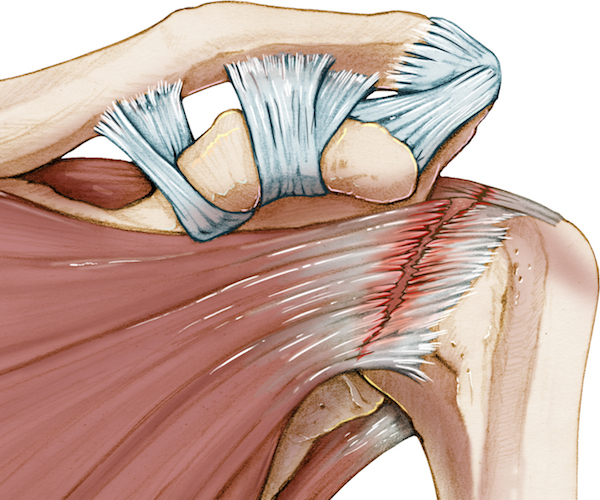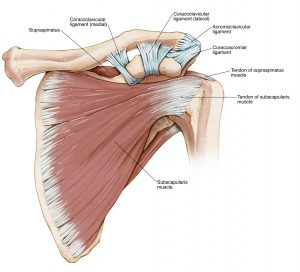In our newsletter today, we feature the rotator cuff tear, a very common pathology that is significantly relevant in the medico-legal world, often resulting in monetary compensation upon the impairment assessment by an orthopaedic expert.
After a short description of this pathology, we refer to the link you can find on our website to explore the full content. In this introduction, we elaborate on the incidence and relevance of shoulder injury and disease in work-related compensation matters based on published statistics by a variety of Australian organisations.
What is a rotator cuff tear?
A rotator cuff tear involves of the rupture of one or more tendons forming the shoulder’s rotator cuff.
The shoulder’s rotator cuff consists of the assembly of tendons originating from three muscles, the supraspinatus, infraspinatus and subscapularis joined together to form a cuff around the shoulder joint (gleno-humeral joint). Together these muscles and tendons stabilise the head of the humerus within the shoulder joint and are essential to allowing its wide range of movement. Due to its unique structure and function, the rotator cuff is susceptible to injury and overuse.
Injuries and disorders of the rotator cuff are frequent in young males due to sport and professions requiring intense physical activities of the shoulder. According to cadaveric reports, in older individuals a tear of the rotator cuff is quite frequent albeit asymptomatic.
How shoulder injuries affect the worker
Often a worker affected by a shoulder rotator cuff pathology needs to be retrained while activities such as heavy lifting, pushing and carrying weights are avoided during the early recovery phase. Ad interim, the patient benefits from a professional ergonomic examination of the workplace, changing job roles, having frequent periods of rest, and the use of devices that may help prevent the strain to the shoulder musculature.
Although a variety of conservative and surgical therapies are available to repair a rotator cuff tear, this pathology can bring along possible complications that may impair a full functional recovery and thus a swift return to work or physical activities.
Compensation for a shoulder injury
Under the WorkCover system 2019, a shoulder injury can result in an impairment lump sum of a minimum of $21,000. This can become much higher if the shoulder injury is more severe, for instance when surgery is required.
The success of a common law lump claim for a shoulder injury can vary between $80,000 and $200,000 on a pain and suffering only basis. The exact compensation depends on the impact the shoulder injury has on the client’s life. The client can be also entitled to be compensated for the loss of income, relative to the work capacity in the future. A maximum amount of $1.249,300 million can be compensated for the loss of earnings.
According to Safe Work Australia, the analysis of the 2019-2020 period published in 2021, reported all work-related injuries and diseases, whereby body stressing caused 37% of serious claims and falls/trips 23% of all claims, and being hit by a moving object 16%.
The nature of injury analysis reported 38% involving traumatic joint, ligament and muscle-tendon injury, 18% musculoskeletal and connective tissue diseases, 16% wounds, lacerations, amputations and internal organ damage.
Concerning the bodily location, the neck and shoulder combined resulted in 13% of all serious claims, behind the upper limbs at 25%, lower limbs at 23%, the back at 18%, etc.
When the incidence of serious claims was divided by occupations, labourers had a 24%, community & personal service workers 19%, machinery operators & drivers 14%, and technicians and trade workers 19%.
A total of 120,355 serious claims were lodged in 2019-2020. , leading to the median compensation of $13,500, and a median lost working time of 6.6 weeks.
Statistics on work related shoulder injuries
Injuries to the shoulder have important consequences for the work insurer and the medico-legal communities involved in the compensation process. In a previous report from Australian Workers compensation in 2017-2018, injury and musculoskeletal disorders accounted for 88.5% of all serious claims totalling 107,335 serious claims of that period.
Of these, the most common were traumatic joint/ligament and muscle/tendon injuries, accounting for 38% of all injury and musculoskeletal disorders claims. Both male and female employees recorded similar proportions of claims from traumatic joint/ligament and muscle/tendon injuries at 39% and 37%, respectively.
Interestingly, the number of serious claims has fallen from 133,000 in the year 2000-2001 to 106,500 in 2017-2018, which is a reduction of 20%.
However, the number of claims involving the shoulder were 12,250 in total for the 2019-2020 period, 10% further compared to the 2017-2018 period.
More detailed statistics are only found for the period of 2017-2018, highlighting various mechanisms of injury that affect specific body parts.
Body stressing resulted in the highest number of claims with over 38,000 serious claims being 38% of all claims. Shoulder injury was the second highest with 19% claims after those involving the back (lower and upper) being 38% of the total.
Falls and slips amounted to over 24,000 serious claims, whereby the shoulder was the fourth highest with 9% claims, following the knee at 20%, the ankle at 17% and the back at 11%.
Hit by a moving object led to over 17,000 serious claims affecting the hands/fingers at 38%, the foot/toes at 9%, the knee at 5% and the shoulder at 4%.
Vehicle accidents resulted in over 8,500 serious claims mostly affecting the back at 15%, the hands/fingers at 10% and the shoulder at 9%.
These statistics highlight the key role shoulder injuries and conditions play in the medico-legal sector and monetary compensation for an impairment.
For further information on the rotator cuff tear, please read the pathology here https://pathologies.lexmedicus.com.au/collection/shoulder-rotator-cuff-tear
To understand the shoulder anatomy click this link https://anatomy.lexmedicus.com.au/collection/shoulder
Find the tests used by a medico-legal expert to assess the impairment of the shoulder here https://examination.lexmedicus.com.au/collection/shoulder


